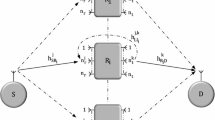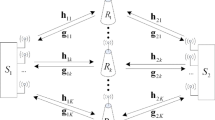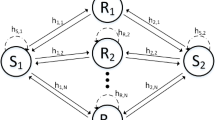Abstract
One-way wireless relay networks have recently received a lot of attention due to their ability to provide spatial diversity in fading wireless environment. Moreover, performing single-relay selection is a very attractive method due to its cost effective implementation and superior performance. However, one-way relay networks with the half-duplex signalling suffer from a spectral efficiency loss. To overcome such a drawback, two-way wireless relay networks have been proposed and these are also the networks considered in this paper. The paper analyzes the diversity orders of various relay selection schemes, including the best-relay selection, best-worse-channel selection, and maximum-harmonic-mean selection. The analysis is done for the amplify-and-forward protocol and under the two-step and three-step transmission procedures. In particular, it is shown that full diversity orders of R and R + 1 can be achieved in a R-relay wireless network with the two-step and three-step procedures, respectively. Numerical and simulation results are provided to verify our analysis.
Similar content being viewed by others
References
Marzetta T., Hochwald B. (1999) Capacity of a mobile multiple-antenna communication link in Rayleigh flat fading. IEEE Transactions on Information Theory 45(1): 139–157
Foschini G. (1996) Layered space-time architecture for wireless communication in a fading environment when using multi-element antennas. Bell Labs Technical Journal 1: 41–59
Sendonaris A., Erkip E., Aazhang B. (2003) User cooperation diversity, Part I: System description. IEEE Transactions on Communications 51(11): 1927–1938
Sendonaris A., Erkip E., Aazhang B. (2003) User cooperation diversity, Part II: Implementation aspects and performance analysis. IEEE Transactions on Communications 51(11): 1939–1948
Jing Y., Hassibi B. (2006) Distributed space-time coding in wireless relay networks. IEEE Transactions on Wireless Communications 5(12): 3524–3536
Laneman J., Wornell G. (2003) Distributed space-time-coded protocols for exploiting cooperative diversity in wireless networks. IEEE Transactions on Information Theory 49: 2415–2425
Ribeiro A., Cai X., Giannakis G. (2005) Symbol error probabilities for general cooperative links. IEEE Transactions on Wireless Communications 4: 1264–1273
Laneman J., Tse D., Wornell G. (2004) Cooperative diversity in wireless networks: Efficient protocols and outage behavior. IEEE Transactions on Information Theory 50: 3062–3080
Zhao Y., Adve R., Lim T. (2007) Improving amplify-and-forward relay networks: Optimal power allocation versus selection. IEEE Transactions on Wireless Communications 6: 3114–3123
Bletsas A., Shin H., Win M. (2007) Outage optimality of opportunistic amplify-and-forward relaying. IEEE Communications Letters 11: 261–263
Bletsas A., Khisti A., Reed D., Lippman A. (2006) A simple cooperative diversity method based on network path selection. IEEE Journal of Selected Areas in Communications 24: 659–672
Rankov B., Wittneben A. (2007) Spectral efficient protocols for half-duplex fading relay channels. IEEE Journal of Selected Areas in Communications 25: 379–389
Lee, N., Park, H., & Chun, J. (2008). Linear precoder and decoder design for two-way af MIMO relaying system. Proceedings of the IEEE Vehicular Technology Conference (pp. 1221–1225). May 2008.
Hausl C., Hagenauer J. (2006) Iterative network and channel decoding for the two-way relay channel. Proceedings/IEEE International Conference on Communications 4: 1568–1573
Rankov, B., & Wittneben, A. (2006). Achievable rate regions for the two-way relay channel. Proceedings of IEEE International Symposium on Information Theory (pp. 1668–1672). July 2006.
Popovski, P., & Yomo, H. (2007). Physical network coding in two-way wireless relay channels. Proceedings of IEEE International Conference on Communications (pp. 707–712). June 2007.
Cui, T., Gao, F., Ho, T., & Nallanathan, A. (2008). Distributed space-time coding for two-way wireless relay networks. Proceedings of IEEE International Conference on Communications (pp. 3888–3892). May 2008.
Cui, T., Ho, T., & Kliewer, J. (2008). Memoryless relay strategies for two-way relay channels: Performance analysis and optimization. Proceedings of IEEE International Conference on Communications (pp. 1139–1143). May 2008.
Zhao Y., Adve R., Lim T. J. (2006) Symbol error rate of selection amplify-and-forward relay systems. IEEE Communications Letters 10: 757–759
Jing Y., Jafarkhani H. (2009) Single and multiple relay selection schemes and their achievable diversity orders. IEEE Transactions on Wireless Communications 8: 1414–1423
Gradshteyn I. S., Ryzhik I. M., Jeffrey A., Zwillinger D. (2000) Table of integrals, series, and products. Academic Press, San Diego
Author information
Authors and Affiliations
Corresponding author
Rights and permissions
About this article
Cite this article
Nguyen, H.X., Nguyen, H.H. & Le-Ngoc, T. Diversity Analysis of Relay Selection Schemes for Two-Way Wireless Relay Networks. Wireless Pers Commun 59, 173–189 (2011). https://doi.org/10.1007/s11277-009-9911-0
Published:
Issue Date:
DOI: https://doi.org/10.1007/s11277-009-9911-0




